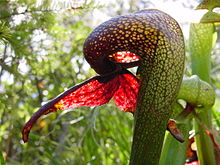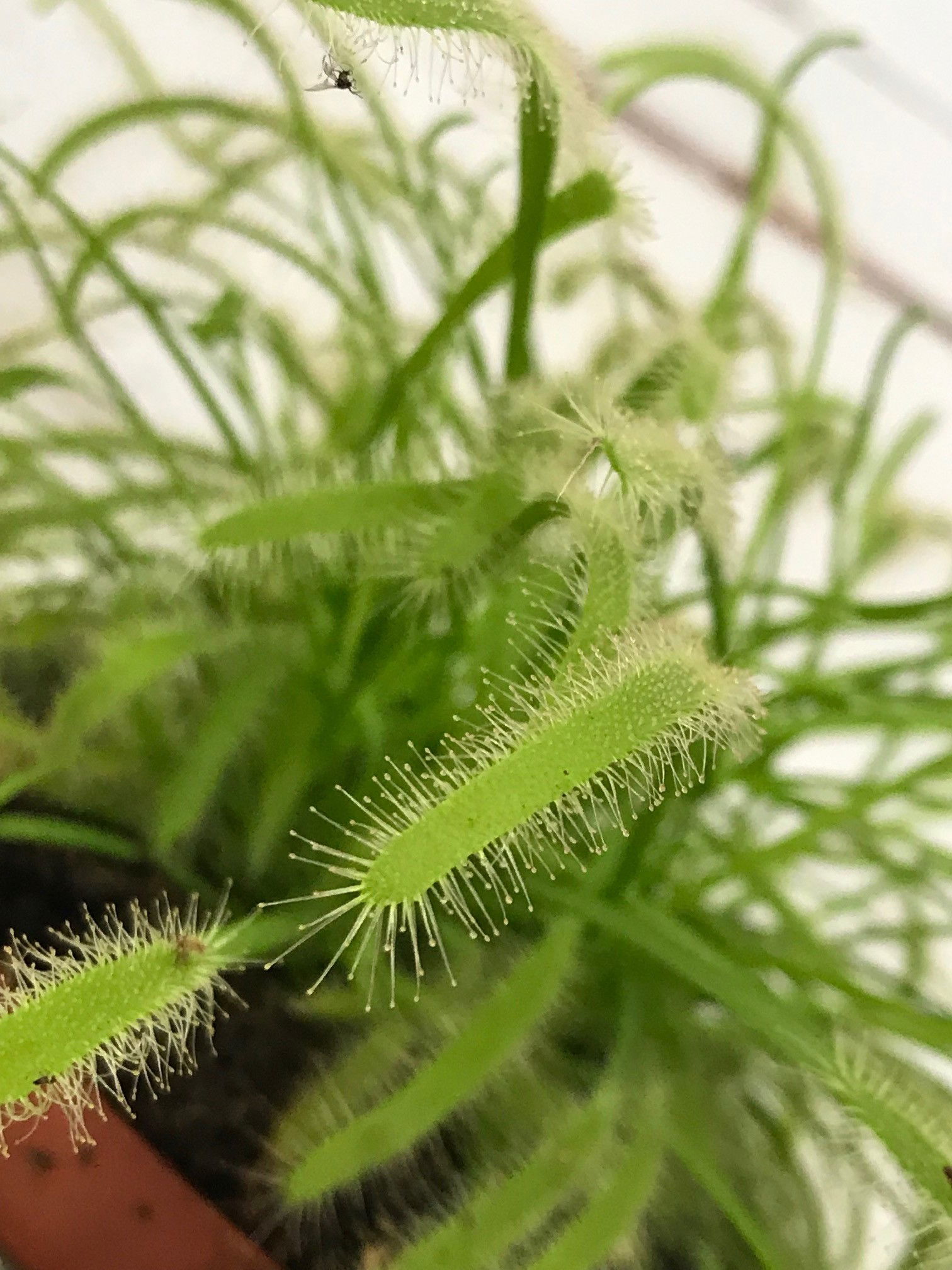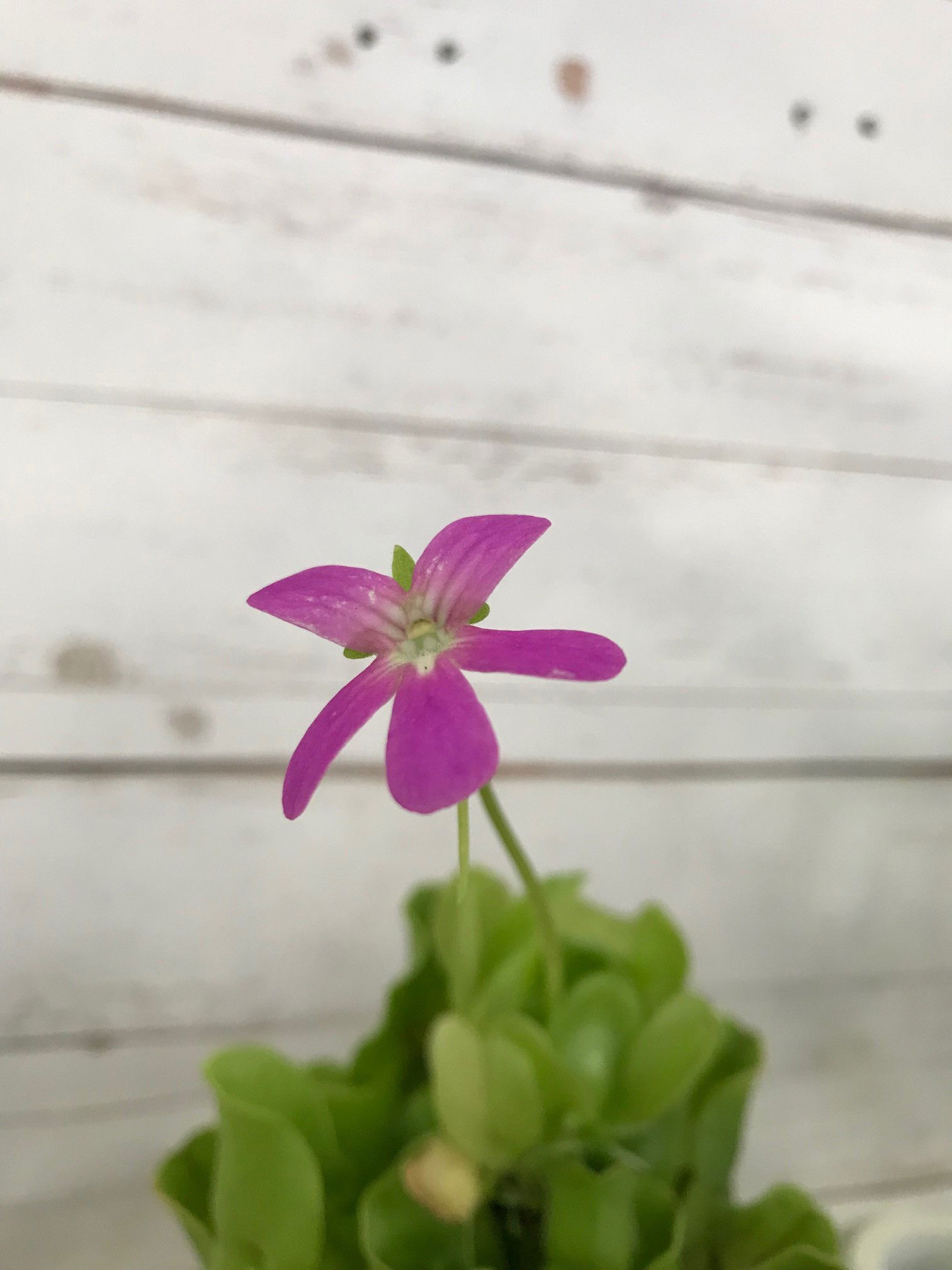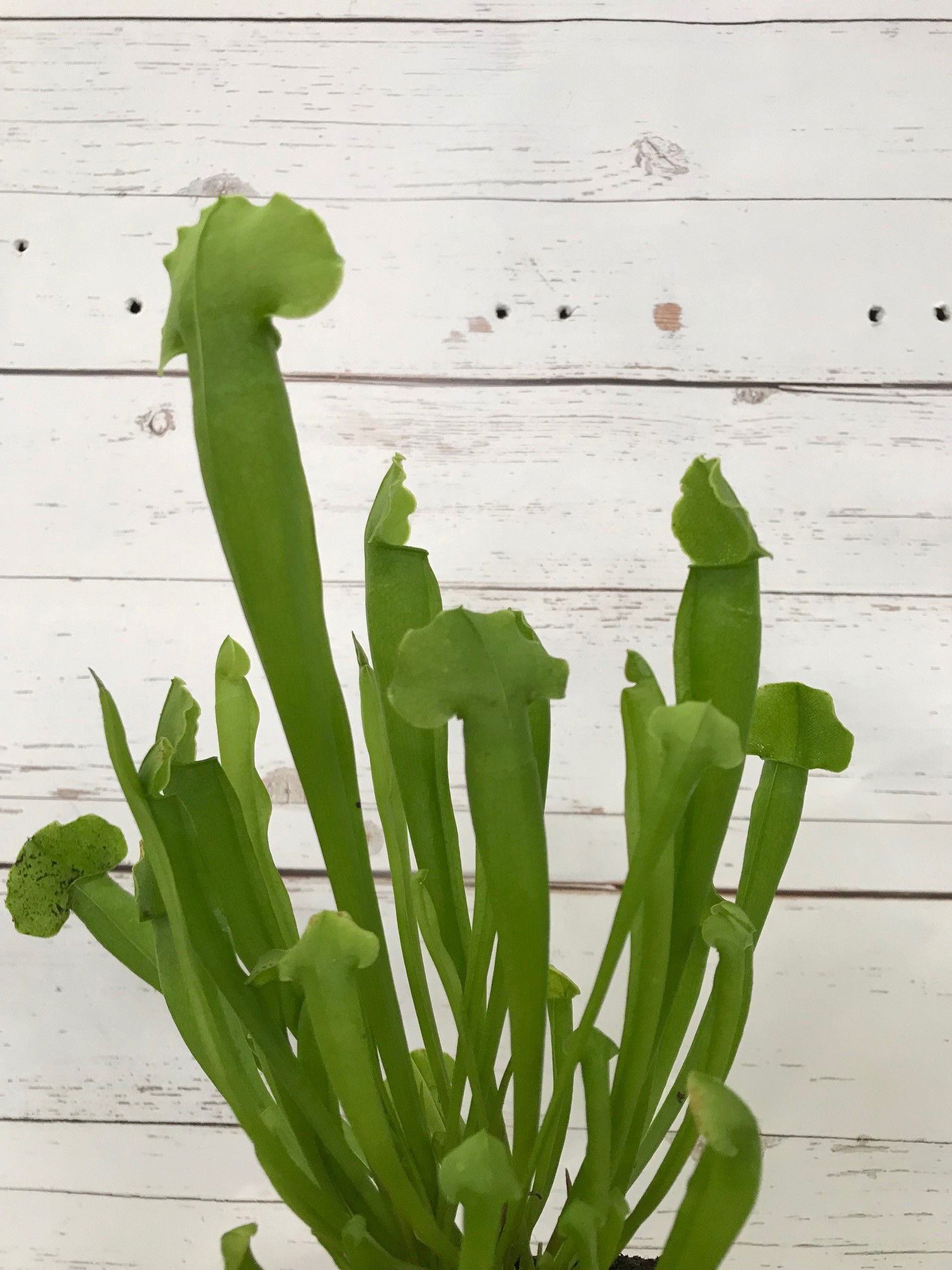
Darlingtonia californica. Copyright: Noah Elhardt
Contents
- Top Tips
- Introduction
- Location, Water, Humidity & Fertilisation
- Dormancy Care
- Common Issues
- Origins, Temperature, Propagation, Repotting & Toxicity.
Need the answer to a specific plant query? Book a 1-to-1 video call with THE HOUSEPLANT DOCTOR™, the website's friendly author, to overcome and address your niggling problem! Available on iMessage, WhatsApp, Facebook Messenger & more.
Top Tips & Info
- Care Difficulty - Easy
- Maintain evenly moist soil all of the time, averting the risk of short-lived droughts.
- A few hours of either morning or evening sun is highly beneficial for all Carnivorous plants. Avoid situating the specimen in any other location as crown rot and death are common issues among dark settings.
- Feed one live insect a week, reducing this to monthly in the autumn and winter. Do not over-feed or give the specimen any other plant-fertiliser as it'll lead to root burn and death. Place the specimen outside during the spring and summer for it to catch its prey and regain its health.
- Repotting is a rare practice for carnivorous plants, as their root systems tend to be quite sparse. Only use a 'Carnivorous' labelled potting mix during a transplant, as anything else will contain too many chemicals that'll lead to fertiliser-burn.
- If possible, keep it outdoors in a sheltered location once the nighttime temperatures are above 10⁰C (50⁰F). Its growth rate and overall health will immensely benefit from the fresh insects and good lighting.
- It's entirely reasonable for a loss of older foliage over the winter months; as long as there's still a few healthy leaves leftover, it'll bounce back in the spring in no time!
Introduction
Many people will have a vague idea of how the mechanics of the plant works; however, the science behind this is far more enjoyable. The sole reason in which the plant catches prey is to do with the lack of chemicals like nitrogen and phosphorus in the soil. Evolution has presented them with ability to secrete digestive enzymes that are triggered once the trichomes of the traps, pads or hollow tubes, sense prey is near. The insect is lured into the deadly traps or pads via scents of nectar, or possible bright colours that mimic flowers or fruits. All what is left, is the exoskeleton that once belonged to a curious creature.
Location & Light - 🔸🔸🔸
Situate either outside in a shaded area, or by a bright window to receive a few hours of off-peak sunlight per day. Those grown in too bright locations will cause stunted growth, brown leaf edges and burnt leaves. Never offer any carnivorous plant a spot that would be difficult to read a newspaper from, due to the heightened chance of moisture-related diseases caused by continual moist compost.
Water - 🔸🔸🔸
Moist compost is mandatory at all times; monitor those grown in sunny locations or outside every day to avoid drying soil. Pure rainwater is the only option long term, as any other alternative will contain certain chemicals that will slowly damage the roots. During spring and summer, maintain evenly moist compost and irrigate using the bottom-up method via submersion. Although watering from the top won't kill the plant, it could lead to botrytis due to high moisture levels of both the soil and surrounding air. During the colder months, never allow it to sit in standing water 24/7 as this is to replicate its much-needed dormancy period - Pinguicula is the only exception and should be kept in around 2.5cm (1 inch) of water continuously. Under-watering symptoms include stunted growth, brown leaf edges or rapidly declining crispy leaves, commonly caused by forgetfulness or too much sunlight or heat. Over-watering symptoms are a rotting crown and yellow/brown lower leaves which are usually typical for plants grown in too dark locations.
Which are the best types of water to use on a Carnivorous Plant are:
- Rainwater (dirty looking water is fine!)
- Deionised water
- Distilled water
- Water from a dehumidifier
If you don't have access to these waters, try boiling tap water and sitting it on the side for 12 hours, before running it through a Brita-style filter.
Which are the worse water Types? Do NOT Use:
- Pond water that is high in nitrates (fish excrement)
- Bottled mineral or spring water (or if it's high in lime).
Humidity - 🔸🔸
As most carnivorous plants' natural habitat are in boggy climates or jungles, humidity needs to be at the forefront. Although moist soil will provide some surrounding moisture, be sure to finely mist once or twice a week to increase this. Introduce a humidity tray of some description to maintain a stable level of air moisture. Be careful of the possibility of over-misting, as this will lead to powdery mildew or even botrytis if light and air circulation are poor.
Fertilisation - 🔸
Many people panic over what to feed their carnivorous plant. Natural prey like spiders, flies, mosquitoes, even slugs, and other small insects are the only food that it should digest. Never feed it cake, meat or stones as this will kill the individual trap or even spell the end of the plant's life. Dead insects should be avoided too as the trichomes can detect whether or not there's something inside it, and if the prey doesn’t move, the trap won’t digest it. Never allow it to swallow something bigger than one-third of the trap's size as the plant won't be able to digest it fully, wasting vital energy in the process.
 Drosera Capensis; the name, drosos, derives from Greek meaning 'dewdrops' which refers to the shape of the leaves.
Drosera Capensis; the name, drosos, derives from Greek meaning 'dewdrops' which refers to the shape of the leaves.
Dormancy Care
The final element for a long-lasting carnivorous plant is a vital resting period during the autumn and winter months. While keeping the soil moist, reduce insect-feeds to almost none, as in the wild airborne prey tend to be less in numbers during this time. Reduce the ambient temperature to around 12℃ (54℉) during the night to reinforce this critical period - even a cool windowsill will be sufficient enough. If its dormancy is served well, you'll be rewarded with a flurry of juvenile growth towards the start of spring season.
Those that don't serve an adequate dormancy period will show signs of weak spring growth, along with a shorter life span.
Common Issues with Carnivorous Plants
Too little light accompanied by water-logging will cause the lower leaves to rapidly yellow and rot. Although this is the natural response to ageing on a smaller extent, persistent yellowing and a near absence of foliage should only occur during late autumn. If this is the case during the height of summer, action must be taken immediately. Place the traps in a location that receives little direct sunlight out of peak hours, or outside if possible. Although it will take several weeks for the plant to start to recover, better-growing conditions with the occasional insects will significantly benefit it, thus resulting with a much happier plant.
Green Aphids can wreak havoc with younger specimens if untreated. The neon-green critters will predominantly inhabit the flowers and stalks, leaving white casings on the foliage below. Initially, the plant won't show any signs of pest-damage; but after a while, small white shells will appear around the base of the plant, thus signalling the start of an infestation. For its eradication, spray garlic water onto the affected areas several times over the week's course. If the population's numbers won't reduce, repeat weekly or move onto chemical pesticide - remember to keep the plant away from other unaffected specimens to avoid it spreading.
Under-developed traps are commonly caused by persistent under-watering or too much sunlight. Dry soil must be avoided at all times for success as they grow naturally in bog climates. After a few weeks of moist soil, better growth should start to develop.
Cold tap water will quickly damage the plant with foliage-loss and stunted growth. The cold temperatures and high levels of chloride typically found with taps water should be replaced by either rainwater or fresh bottled water. If you were to use water from the tap, help the situation by allowing it to stand for 24hrs in a non-mental container before application.
 The flower of a Pinguicula in full bloom.
The flower of a Pinguicula in full bloom.
Temperature
12° - 38°C (54 - 100°F)
H1b (Hardiness Zone 12) - Can be grown outdoors during the summer in a sheltered location with temperatures above 12℃ (54℉), but is fine to remain indoors, too. If you decide to bring this plant outdoors, don't allow it to endure any direct sunlight as it may result in sun-scorch and dehydration. Regularly keep an eye out for pests, especially when re-introducing it back indoors.
Spread
Drosera - 0.5m in both height and width. Maturity is reached within 2 years.
Pinguicula - 0.2m in height, and 0.3m in width. Maturity is reached within 4 years.
Cephalotus - 1 - 5cm in height, and 10cm in width. Maturity is reached within 3 years.
Darlingtonia - 0.5m in height, and 0.4m in width. Maturity is reached within 3 years.
Nepenthes - 1.5m in height, and 0.3m in width. Maturity is reached within 8 years.
Pruning & Maintenance
Remove yellow or dying leaves, and plant debris to encourage better-growing conditions. While pruning, always use clean utensils or shears to reduce the chance of bacterial and fungal diseases. Never cut through yellowed tissue as this may cause further damage in the likes of diseases or bacterial infections. Remember to make clean incisions as too-damaged wounds may shock the plant, causing weakened growth and a decline in health.
 The foliage of a Sarracenia flava which has downwards pointing hairs which will cause the prey to fall into the pit of enzymes.
The foliage of a Sarracenia flava which has downwards pointing hairs which will cause the prey to fall into the pit of enzymes.
Propagation
Drosera (Sundews) - Leaf Cuttings
Pinguicula (Butterwort) - Division or Leaf Cuttings
Cephalotus - Leaf/Root Cuttings or Division.
Darlingtonia & Sarracenia (Pitcher Plants) - Offshoots via Rhizomes (Division)
Nepenthes - Stem Cuttings & Division.
Division (Easy) - The best time to divide is during the repotting period in the spring or summer. For the prevention of transplant shock (common with heavy-handed transplants), water the plant 24hrs before the main event. Gently tease away some of the soil, separating a lateral offset that is half of the mother plant's size, with healthy root systems. Do not touch, or over-finger the roots as the small hairs are very sensitive and may cause death in some instances. Place the plantlet into a moist 'Carnivorous Compost' and avoid direct sunlight with prolonged droughts for best results.
Stem Cuttings (Difficult) can be taken at the start of spring when there's more than 10cm (4 inches) of semi-wooded stem. This will take a while, as the plant will need to reach a certain level of maturity before its base becomes ready. While using clean secateurs, remove the top 10cm of the stem just above a node and gently remove the lower leaves. Place the bottom half of the specimen into 'Carnivorous Compost' and be sure not to submerge the leaves. Wrap the plant (& its pot) in a transparent bag to maintain high humidity due to the absence of roots that'll result in rapid moisture loss within the stem. Provide a bright, indirect location with continual soil moisture to quicken the rate of root development. Remove the bag after four weeks of substantial foliar growth and follow the care advice provided at the top of the article.
Repotting
Repot every few years using 'Carnivorous Compost' and the next sized up pot; never use any other compost as the chemicals found in these soils will burn the roots.
Pests & Diseases
Keep an eye out for mealybugs, aphids, spider mites, scale, thrips, whitefly, blackfly, vine weevils & root mealybugs that'll locate themselves in the cubbyholes and undersides of the leaves, with the exception of the latter two in the soil. Common diseases associated with Carnivorous Plants are root rot, leaf-spot disease, botrytis, rust, powdery mildew & southern blight - click here to learn more about these issues.
Toxicity
Not known to be poisonous when consumed by pets and humans. If large quantities are eaten, it may result in vomiting, nausea and a loss of appetite.
Retail Locations
Dobbies, IKEA, B&Q, Homebase, Facebook Market, Online Stores.
Book a 1-to-1 Call with THE HOUSEPLANT DOCTOR™
If you need further advice with your houseplants, book an advice call with ukhouseplants' friendly and expert writer today! This can be done via a video or audio call on most apps, including Facebook, FaceTime & Skype. A ten-minute call costs £5.99 (US$7), or £15.99 for thirty minutes. You can ask multiple questions, including queries on plants, pests, terrariums, repotting advice and anything in between. Please consider supporting this service to keep ukhouseplants thriving!